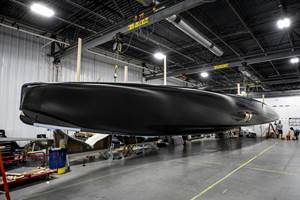Engineering Insights: BMC Creates New Dimensions in Underhood Apps
Specially formulated material enables production of high-tolerance automotive engine air intake component.
The past 20 years have seen the introduction of numerous metal-to-composite conversions in automotive engine-compartment applications. Although weight reduction can be a factor in such conversions, the focus increasingly is on improving performance at the same cost, or reduced costs vs. metallic components through parts integration, materials and processing innovations or both.
Most of the easy substitution of plastics for metals in engine compartments was done in the 1980s and 1990s. Today, composite-for-metal replacement is complicated because the opportunities for part conversion involve more stringent mechanical and thermal demands and, therefore, require the use of high-strength, usually glass-reinforced polymers with excellent mechanical performance at operating temperatures of 140°C/284°F and higher. Fortunately, modern design tools and improved molding technologies are enabling replacement of metals with high-temperature thermoplastics and thermosets in applications that only a few years ago were thought to be too difficult for polymer-based materials.
A case in point is the throttle body used in fuel-injected engines. While some simple mechanical air-control valves have converted to composites, more sophisticated electronic throttle control (ETC) valves steadfastly remained in die-cast aluminum until last year, when 1.4L and 1.6L engines built by a joint venture between automakers BMW (Munich, Germany) and PSA Peugeot Citroën (Paris, France) debuted with ETCs manufactured from injection molded bulk molding compound ( BMC). Used in vehicles such as BMW’s Mini and the Peugeot 207, the ETCs take advantage of dimensional stability advancements offered by a specially-formulated bulk molding compound (BMC) and precision molding technology. Tier 1 air and fuel management systems supplier Siemens VDO Automotive AG (Regensburg, Germany) designed, developed and supplies composite ETCs to BMW and PSA, working with molder Helvoet Rubber & Plastic Technologies NV (Lommel, Belgium) and BMC supplier TetraDUR GmbH (Hamburg, Germany), a subsidiary of Bulk Molding Compounds Inc. (BMCI, West Chicago, Ill.).
Multifunctional device keys engine efficiency
The replacement of conventional carburetors with fuel injection was a major leap in gasoline engine fuel efficiency and emissions control. At first, the flow of air to the engine in injection systems was directly controlled by the movement of the gas pedal via a mechanical linkage between the pedal and the throttle body. But engines developed in the last decade, especially those in Europe, have incorporated the ETC. The ETC uses a more sophisticated system: the gas pedal sends a signal to a sensor that activates a motor housed in the control body. The motor adjusts a valve that controls the amount of air entering the engine. Additionally, oxygen sensors adjust the amount of fuel that is injected to maximize fuel efficiency and reduce emissions. Other electronics optimize engine torque, idle speed control and transmission control to improve the smoothness of the engine and the vehicle ride.
The key to achieving optimum ETC performance is accurate and smooth valve movement and repeatable valve seating — characteristics controlled by the throttle body’s dimensional precision and stability. The traditional method used to manufacture the valve plate and throttle housing is to die cast the parts in aluminum and machine them to the final dimension, a costly extra step. Also, because the parts operate in the engine compartment, they must withstand temperatures as high 150°C/302°F and resist damage from fuels and other engine fluids.
In 2001, faced with rising costs for aluminum and a need to reduce ETC weight and cost, Siemens VDO turned to Helvoet to explore production of ETC bodies in reinforced plastics. Already a significant supplier of high-tolerance, precision-molded components, such as phenolic fuel pump impellers, which require dimensional control at the micron level, Helvoet quickly determined that phenolic and high-temperature thermoplastics, such as polyphenylene sulfide (PPS), would be too expensive. The decision was made to investigate polyester BMCs, in part because they are 40 percent less expensive than aluminum on a cost per cubic centimeter basis. The primary question was whether polyester BMC could meet the demanding tolerance and temperature requirements.
Modified material prevents in-mold shrinkage
The first step in evaluating substitute materials, says Herman Koks, sales/marketing manager for Helvoet, was the fabrication of a test mold, consisting of a cylindrical bore and a flanged landing area around the cylinder. With this tool, Helvoet and Siemens VDO could quickly screen materials for mold shrinkage, concentricity, dimensional tolerances and other characteristics. In mid-2002, TetraDUR was invited to submit a range of compounds for evaluation. “We had to make some modifications to obtain a material that met the requirements,” notes Brett Weber, currently VP of European and Asian operations for TetraDUR’s parent, BMCI. At the time of development, Weber was stationed in Europe and active in the material’s development. He explains that the conventional method for formulating low-shrink molding compounds involves the use of thermoplastic additives in the base polyester resin. The additive, however, often reduces the compound’s mechanical strength and thermal performance, so a delicate balance between part dimensional stability and performance must be achieved.
In the end, the selected material, BMC L4220, was a mixture containing 15 percent chopped glass and 60 percent specially blended mineral fillers in a modified polyester resin. It provides thermal performance above the required 150°C/302°F, and the coefficient of thermal expansion (CTE) is 18µ/m/°C (18 microinches/inch/°C), very close to that of aluminum and less than half that of glass-reinforced thermoplastics. The compound easily passes all the requirements for strength and chemical resistance, including resistance to FAM-B, a high-methanol proxy fuel mixture used for testing, which Weber says is more severe than 90 percent of the fuels sold in Europe.
Significantly, the BMC L4220 exhibits near-zero in-mold shrinkage such that the molded part dimensions are an accurate replication of the mold cavity. As a result, it produces parts with exceptional dimensional repeatability. The measured variability of the BMC parts is typically one-fourth to one-half the allowed diametrical tolerance, which for the throttle body’s bore size of 60.05 mm/2.36 inches, is only ±0.05 mm (±0.002 inch), permitting proper operation of the valve plate, which is now produced in PPS (polyphenylene sulfide) with a steel shaft. This means the parts need no postmold machining. After demolding, they are deflashed and ready to ship, emphasizes Koks. “There’s no machining or postcuring,” he notes, “and no threaded inserts to install.” Instead, bolts pass through the housing’s mounting holes and into threads in the engine’s intake manifold.
The housing was designed in two halves, an upper and lower, each approximately 7.25 inches long by 7 inches wide (184 mm by 178 mm). When assembled, the halves encase the motor that operates the air valve, with the 3.5-inch/89-mm high assembly’s parting line placed at the pivot point of the valve plate. The initial production molds, a two-cavity tool each for the upper and lower shells, were made from hardened steel (the European equivalent of H13) and chrome plated for increased durability. (Koks says a four-cavity mold for the lower shell will be in production later this year to compensate for production differences between the upper and lower shells.) Molds are outsourced from a local vendor, and parts are produced on injection molding equipment provided by KraussMaffei GmbH (Munich, Germany). Because the part is based on an aluminum design that features thick, solid mounting flanges, wall thickness of the BMC parts vary considerably, from 2 mm/0.080 inch to more than 10 mm/0.400 inch, says Weber. Injection molding cycle times are still relatively short at less than 80 seconds. While thermosets can be molded with greater thickness variation than thermoplastics without creating large stresses and warping, a design optimized for BMC by reducing thickness in the flange area could shorten cycle time further. “The aluminum designs have had many years to be refined,” Kok points out, noting that BMC throttle bodies will undergo similar transformation. “New parts are being designed specifically to take advantage of the BMC’s properties.”
Development of the manufacturing process was aided by the use of mold flow analysis, performed by consulting firm Corex Design Group Inc. (Glen Rock, N.J.), and multiple design iterations, which were conducted by Siemens VDO and Helvoet. Special care was taken to minimize knit lines and move those that occur to the lowest stress areas of the part. Prior to successful field durability and performance testing by BMW and Peugeot, Siemens VDO satisfactorily completed its own rigorous dimensional analysis of the parts. Assembled throttle controls were put through demanding tests for stress cracking, bolt torque resistance and humidity as well as temperature and mechanical fatigue, which validated the capabilities of the selected materials and the molding technique.
Production started in mid-2006, and the finished upper and lower housings are shipped to Siemens VDO facilities in Bebra, Germany, where the motors are enclosed and the two halves are bonded together with epoxy adhesive to seal the unit. The BMC housing is approximately 25 percent lighter than the aluminum one it replaces. Approximately 500,000 units will be made this year, and Koks says the figure will escalate to more than 1 million in 2008 as additional vehicles incorporate the new engines.
Production accelerates at rapid pace
Koks sees additional advantages to manufacturing such parts in BMC rather than aluminum. It’s cheaper and faster to set up an injection molding cell close to the Tier 1 customers, in one of the global Helvoet facilities, than to set up an aluminum die casting operation, he explains. Further, local production is eased by the fact that BMCI already has compounding sites in China, Brazil, Mexico, the U.S. and Europe, so supply logistics for the raw material are already in place for key markets.
The favorable combination of production efficiency and logistics has encouraged additional Tier 1 suppliers and OEMs to initiate conversions of ETCs from aluminum to BMC, with at least one other program already in production. Weber predicts that the market for composite ETCs will reach or exceed 4.5 million units by 2010 with the potential for much more growth, considering there are 30 million vehicles built annually in Europe and North America alone.
Related Content
Belzona composite wrap restores corroded carbon steel pipeline
Two-part epoxy paste, epoxy structural adhesive, composite wrap and anti-corrosion coating prevent environmental and economic loss for customer.
Read MoreHeat-activated foaming core rapidly achieves net-shape 3D parts
CAMX 2024: L&L Products exhibits its InsituCore foaming core structural technology, which can be used to create foam core composites minus machining or presses, as well as the Phaster A K-700, a rapid-cure adhesive.
Read MoreHenkel receives Airbus qualification for European aerospace manufacturing facility
The adhesive company’s Montornès, Spain, plant has been approved as a standard and raw materials supplier for various Airbus platforms, adding to its work in lightweighting, fuel efficiency and automation.
Read MorePro-Set named official materials supplier for New York Yacht Club American Magic
Competitive sailing team prepares for the 37th America’s Cup beginning in August 2024 with adhesives, resins and laminate testing services for its AC75 monohull construction.
Read MoreRead Next
Developing bonded composite repair for ships, offshore units
Bureau Veritas and industry partners issue guidelines and pave the way for certification via StrengthBond Offshore project.
Read MoreVIDEO: High-volume processing for fiberglass components
Cannon Ergos, a company specializing in high-ton presses and equipment for composites fabrication and plastics processing, displayed automotive and industrial components at CAMX 2024.
Read MorePlant tour: Daher Shap’in TechCenter and composites production plant, Saint-Aignan-de-Grandlieu, France
Co-located R&D and production advance OOA thermosets, thermoplastics, welding, recycling and digital technologies for faster processing and certification of lighter, more sustainable composites.
Read More





















